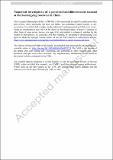Numerical investigation of a potential landslide-induced tsunami at the Suofengying reservoir in China
Author(s)
Kafle, Laxman; Xu, Wen-Jie; Nagel, Thomas
Download10346_2024_2217_ReferencePDF.pdf (710.9Kb)
Publisher Policy
Publisher Policy
Article is made available in accordance with the publisher's policy and may be subject to US copyright law. Please refer to the publisher's site for terms of use.
Terms of use
Metadata
Show full item recordAbstract
Landslides are a severe geohazard around the world. When moving soil masses discharge into a large water body, a tsunami can be generated and exacerbate the devastating effects of the landslide as well as extend the affected area. In this study, based on on-site geological investigation and monitoring, a numerical depth-averaged, two-phase model is established for a hypothetical tsunami in the Suofengying reservoir induced by the potential Bianjiazhai landslide in China which has been previously identified as critical. The analysis of the simulation results shows that the maximum wave amplitude measured at gauge point closest to the landslide is 31 m, and the tsunami reaches the reservoir’s dam about 66 s after the landslide initiation. The inundation map provides potential risk areas that could be affected if a landslide occurs with the anticipated characteristics. Under similar conditions, the research results will help guide reservoir operation and landslide-tsunami disaster prevention. Simultaneously, examining the sequence of events in the tsunami disaster chain facilitates the analysis of the fundamental physics governing the propagation of tsunamis within reservoirs. This analysis contributes to the prediction and prevention of landslide-induced tsunami disasters occurring along reservoir banks.
Date issued
2024-02-10Department
Massachusetts Institute of Technology. Department of Civil and Environmental EngineeringJournal
Landslides
Publisher
Springer Berlin Heidelberg
Citation
Kafle, L., Xu, WJ. & Nagel, T. Numerical investigation of a potential landslide-induced tsunami at the Suofengying reservoir in China. Landslides 21, 1083–1093 (2024).
Version: Author's final manuscript